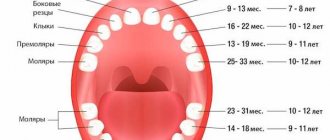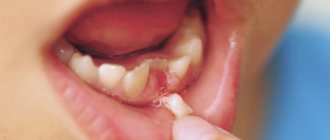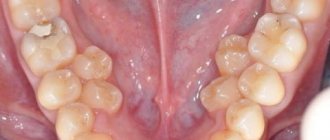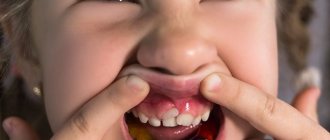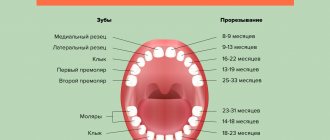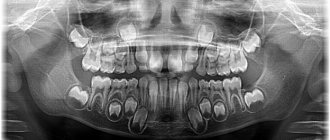Teething: sequence and timing
Normally, teething in babies occurs according to the scheme below:
- central incisors: at 6 months. – in the lower dentition, at 8 months. – on the upper jaw;
- lateral incisors: at 10 months. – in the top row, at 11-13 months. – on the lower jaw;
- first molars (at one year of age);
- canines in the upper row (1 year 4 months);
- canines in the bottom row (1 year 6 months);
- second molars on both jaws (2 years).
The timing of the appearance of the first teeth can vary under the influence of many factors, including:
- toxicosis during pregnancy;
- the presence of Rh conflict;
- prematurity;
- receiving intracranial injury during childbirth;
- infectious diseases;
- congenital hypothyroidism;
- rickets;
- pathology of the pituitary gland;
- neonatal sepsis;
- refusal to breastfeed the baby;
- noticeable weakening of the immune system.
It has been proven that in first-born children, teething occurs much earlier than in infants born at a later time. Boys' first teeth appear later than in girls, while in children of old-time mothers - significantly earlier than in babies born to young parents.
The child's baby teeth are not growing. This is fine?
Many parents worry about when their children will finally get baby teeth. What to do if the baby’s first tooth has not yet come out at six months? What if, at two years old, the child’s mouth still does not have a full set of teeth? Is the order in which teeth appear important or can everything happen individually?
Yulia Selyutina
Pediatric dentist
We decided to ask all these questions to the pediatric dentist and founder of the Dentistry Center Yulia Selyutina (@stomatolog_selyutina) to finally calm parental concerns.
From birth to three years of age, the child—and along with the parents—goes through several stages of development, as a result of which a full set of baby teeth appears in his initially toothless mouth.
There are diagrams and tables that show the timing of the eruption of baby teeth. It is these numbers that doctors and parents often rely on when waiting for the next tooth to appear.
On average, baby teeth begin to erupt at six months, and the last ones appear by two and a half years.
However, it should be remembered that all these terms are relative and highly averaged. Deviations can be either smaller or larger. Sometimes there is a direct dependence on the climate in which the child lives, nutrition, genetic and individual developmental characteristics.
Don’t worry if your baby doesn’t have a single tooth at one year old or if one or more teeth have already erupted at three months. By the way, teeth can come out one at a time or in pairs and even in groups. This is also normal. Even if the first baby tooth erupts closer to a year, there is no reason to worry.
So, if the pediatrician says that everything is in order with the child’s general health, then we put panic aside, allowing the baby’s teeth to appear at the right time for them. Teeth cutting out of order or at the wrong time is not a reason to prescribe medications or vitamins.
Moreover, a dentist has no right to do this. Calcium and vitamins are prescribed only by a pediatrician if there are compelling reasons for this.
Around 2.5–3 years of age, the child has all his milk teeth, that is, 20 teeth. If not all teeth have erupted by this time, then you can worry and urgently make an appointment for a professional examination with a pediatric dentist.
Read more on the topic
The longest baby tooth is included in the Guinness Book of Records
The child does not want to brush his teeth: here are 6 applications that will correct the situation
3 Serious Dental Problems That Children Have (and That Can Be Prevented!)
Who are we and where can you read us?
After all, we have not only a website!
Causes of delayed teeth emergence
A lot depends on nutrition: breastfed babies depend on the quality of breast milk. Babies who grow up on artificial formulas receive slightly more vitamins and minerals, because the formulas contain a clearly calculated amount of nutrients.
- If a child does not have a single tooth at 1 year of age, this may be a consequence of some previous disease: intestinal dysfunction, impaired metabolism, as well as insufficient calcium and vitamin D.
- Teeth may be delayed due to the special course of pregnancy; perhaps the mother suffered complications during the gestation period./li>
- Eruption after 12 months may mean that the tooth is not positioned correctly in the gum, for example, it is growing horizontally.
- Congenital absence of tooth buds in a baby. These are either hereditary disorders or a congenital pathology caused by a disruption in the normal course of pregnancy. It happens very rarely.
How can parents understand that at 12 months the baby’s teeth are simply delayed and they need to be patient, and when should they sound the alarm?
Pediatric dentists allow the first teeth to be delayed for 6 months, so if after the baby’s 1st birthday not a single baby tooth has grown, you should wait a little longer. Try to find out from your relatives about the timing and characteristics of the appearance of the first milk teeth in their childhood, perhaps this is just a family trait.
But if the teeth are already delayed by more than 6 months, and the baby’s gums do not even think of swelling, then you should contact a pediatric dentist. The specialist will conduct an examination and advise what needs to be done to help teeth appear faster.
In addition to the above reasons, the appearance of teeth after 12 months may be affected by the following:
- The teeth are located very tightly in the gums.
- There are diseases of the endocrine system, for example, hypothyroidism, due to which the activity of the endocrine glands is reduced.
- The baby suffered serious systemic diseases.
In this case, the pediatric dentist will recommend a biochemical blood test; the baby will need to have the thyroid gland examined, including an ultrasound examination. After the results are obtained, the dentist will be able to prescribe the necessary course of treatment.
Make an appointment
First aid for teething
When baby teeth appear, the baby may require not only parental care, but also medical attention. The dentist may recommend that parents use anesthetic dental gels and treat the affected areas of the gums with decoctions of sage, oak bark or soda solution. If the pain is severe, the baby may be prescribed paracetamol, ibuprofen and other systemic painkillers.
To ease the discomfort that a child experiences when teething, it is necessary to use teethers - specialized devices made of rubber or plastic that the baby can bite and gnaw on without risking damage to the soft gum tissue. In addition, it is advisable to regularly massage the child’s gums with a finger wrapped in a clean, damp bandage.
Late teeth in children - a problem or the norm?
We have already described in detail what a child’s first teeth are in the article “A Child’s First Teeth – Joy and Responsibility”, what complications there may be during this period of the baby’s development, on a separate page of the site we provide a visual aid on how children’s teeth come in, a photo and a growth chart milk teeth.
In special medical articles, our dentists provide advice and recommendations on how to make this time easier for your baby, how to properly care for the mouth and first teeth (“A pediatric dentist is a must-have best friend from an early age”). Separately, we also focused on the question: what time do children start teething? We repeat - this process is very individual and depends on many factors: heredity, the mother’s lifestyle and nutrition during pregnancy, the baby’s nutrition and the individual characteristics of his body.
Timing of teething in children
Sometimes children are already born with one or more teeth (on average, 1 case per 2-2.5 thousand babies). There is nothing wrong with this, just like with the very early eruption of baby teeth - before 3 months. Parents are even more concerned about late teething in children under one year old. We would like to point out that this is a completely normal condition. The generally accepted standard is 5-7 months - this is the average age of appearance of baby teeth. But the first teeth can appear at 9, 10, 11 months. This is especially true for babies who were born prematurely. And in very premature babies, their first teeth can be delayed even up to 15-18 months. And there's nothing wrong with that. It’s just that when the time comes, the teeth will appear, and, as a rule, by the age of three, such children have a full set of milk teeth, catch up with their peers in all other indicators.
It was previously believed that late teeth in children were often a consequence of rickets and anemia, but modern research has shown that this is not the case. Of course, a lack of calcium and microelements also affects the dental system, but the timing of teething in children is a genetically determined feature of the body. Just like the wrong order of appearance of baby teeth. Even if there are gaps in the dentition, before the eruption of a full set of baby teeth, this is not considered a pathology.
If your child is 10 months old and has no teeth , don’t worry. See our dentist - he will dispel your doubts. But if at the age of 3-4 years the baby is missing several milk teeth, consult an orthodontist at the Utkinzub clinic, who will find out the cause of the pathology and determine measures to avoid such problems with permanent teeth.

